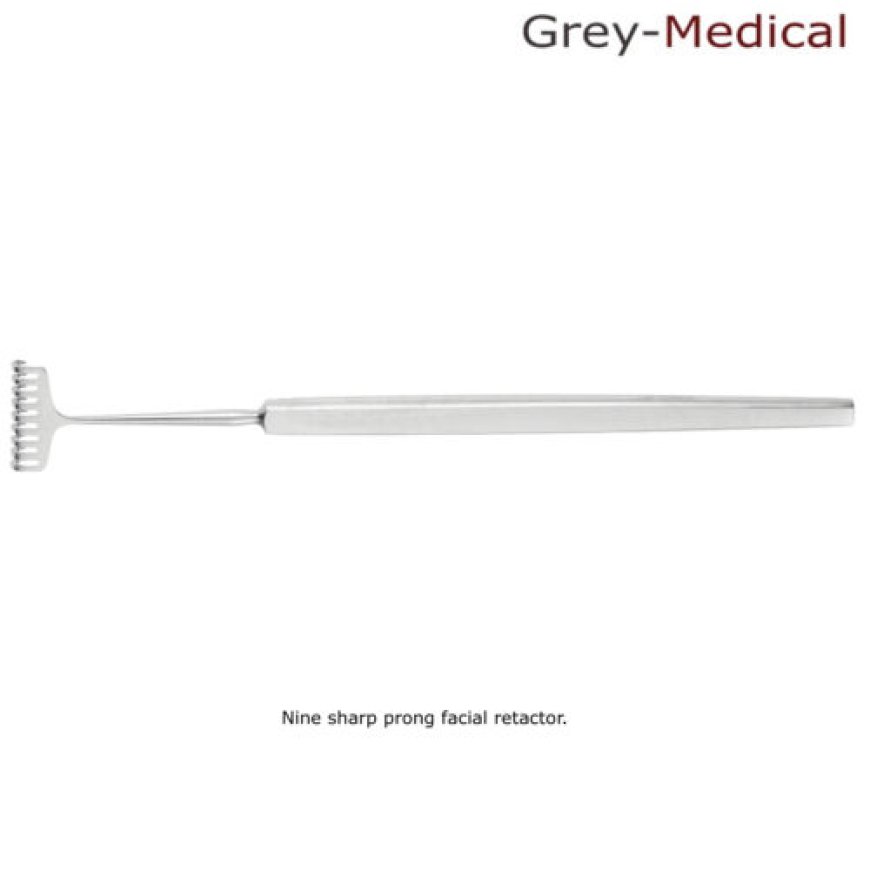Retractor Rake
A rake retractor is a type of surgical instrument used to hold back tissue, muscles, or organs during surgery. The design resembles that of a garden rake, hence its name. The instrument typically features a long handle with pronged ends, allowing the surgeon to gently pull back the tissue and keep it in place. These prongs come in various sizes and are used depending on the type of surgery being performed.

Introduction
In the world of surgical instruments, retractors play a critical role in ensuring surgeons can perform precise operations. Among the many varieties of retractors, the rake retractor stands out due to its unique design and utility in various surgical procedures. Known for its rake-like prongs, this instrument helps maintain optimal visibility by holding back tissues, thereby creating more space and improving access for the surgeon. In this blog, we will dive into the significance of rake retractors, their applications, types, and their essential role in modern surgery.
What is a Rake Retractor?
A rake retractor is a type of surgical instrument used to hold back tissue, muscles, or organs during surgery. The design resembles that of a garden rake, hence its name. The instrument typically features a long handle with pronged ends, allowing the surgeon to gently pull back the tissue and keep it in place. These prongs come in various sizes and are used depending on the type of surgery being performed.
Importance of Rake Retractors in Surgery
In surgeries, precise control over the operating area is essential to prevent complications. This is where rake retractors prove invaluable. By holding back soft tissue, they create a clearer field for the surgeon, allowing them to operate more effectively. The visibility they provide ensures the surgeon can focus on the affected area without interference from surrounding tissues.
Without effective retraction, vital tissues could obstruct the surgeon's view, increasing the risk of unintended damage. Thus, rake retractors not only enhance precision but also contribute to patient safety by minimizing accidental injury.

Common Surgical Procedures Using Rake Retractors
Rake retractors are versatile and used across several types of surgeries. Some of the most common procedures include:
- Orthopedic Surgeries: In orthopedic surgeries, the rake retractor holds back muscles and tissues, allowing surgeons to work on bones and joints more efficiently.
- Plastic Surgery: In delicate procedures such as rhinoplasties or facelifts, small rake retractors are often employed to hold back skin, providing a better view of the surgical area.
- General Surgery: In abdominal surgeries or appendectomies, rake retractors are used to hold back muscles and tissues, giving surgeons access to the organs that need treatment.
Types of Rake Retractors
There are several different types of rake retractors used in surgical settings. Each is designed for a specific application, with the prongs adjusted to the type of tissue and the area being operated on.
-
Sharp Rake Retractor: This type has pointed prongs, making it ideal for holding dense tissues, such as muscles. The sharp ends grip the tissue firmly, ensuring minimal movement during the procedure.
-
Blunt Rake Retractor: Blunt rake retractors are used when softer, more delicate tissues need to be held back. The rounded edges prevent damage to the tissues, making them suitable for surgeries involving sensitive areas like the face or abdomen.
-
Single-Pronged Rake Retractor: These are designed for more focused retraction in smaller areas, such as during plastic surgery. The single prong helps maintain precision while ensuring the surrounding tissue is unaffected.
Materials and Design
Most rake retractors are made of high-quality stainless steel to ensure durability, corrosion resistance, and ease of sterilization. This material is particularly important in medical settings, where instruments must endure repeated sterilization cycles without compromising their integrity.
The prongs and handles of rake retractors are often ergonomically designed to provide comfort for the surgeon during lengthy procedures. Handles may feature grips or curves that ensure the instrument remains secure in the surgeon’s hand, allowing for better control and reduced hand fatigue.
Advantages of Using Rake Retractors
-
Increased Visibility: Rake retractors significantly enhance the surgeon’s ability to see and access the surgical area, resulting in more precise and safer procedures.
-
Tissue Protection: By providing controlled retraction, rake retractors prevent unnecessary trauma to surrounding tissues, reducing the risk of postoperative complications.
-
Versatility: Whether in complex orthopedic surgeries or delicate cosmetic procedures, rake retractors are highly adaptable, making them a staple in various medical disciplines.
Conclusion
Rake retractors are indispensable tools in modern surgery. Their design allows for precise retraction, ensuring surgeons have the visibility they need to perform intricate procedures safely and effectively. From plastic surgery to orthopedic interventions, the rake retractor’s role in ensuring patient safety and procedural accuracy cannot be understated. With advancements in surgical technology and instrument design, these retractors will continue to play a vital role in the operating room for years to come.

 GreyMed
GreyMed